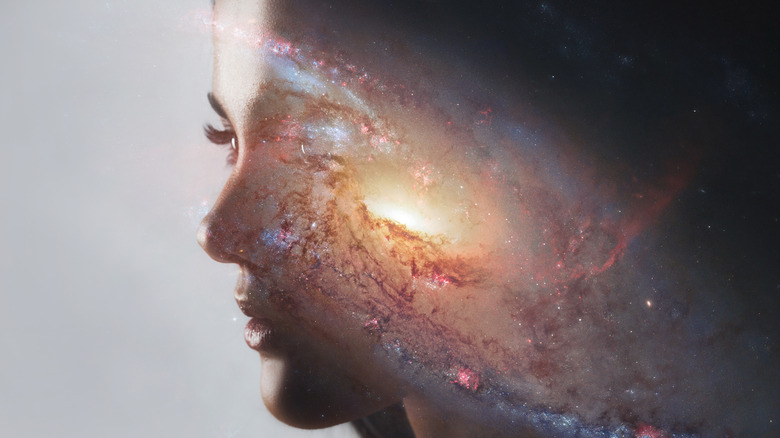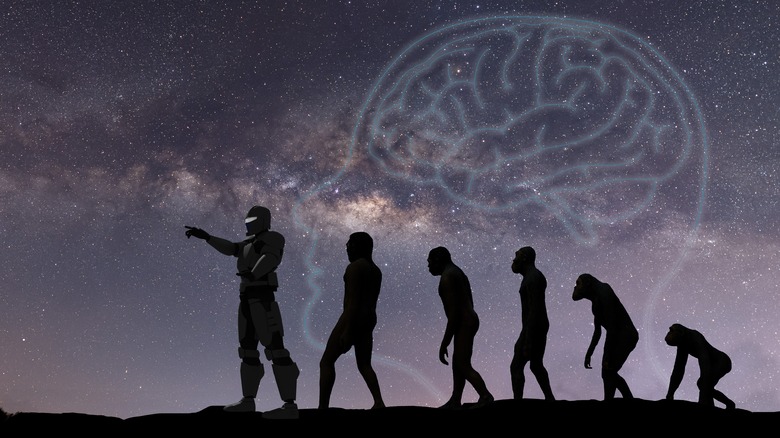How A Theoretical Boltzmann Brain Could Prove Something Comes From Nothing
So here's a question for you: Why does time only move in one direction? "Duh, dude," you might say, "Because my microwaved cup 'o noodle is gonna' be finished in, like, two minutes." Okay, so here's a better question: Why do we remember the past, experience now, but not remember the future? After all, time stretches forward and backward. I can also take a physical step forward and backward through space. But my bodily, sensory "now" is locked into an indivisible time slice that moves forward through a kind of cheese-time block.
This is what physicists call the "block universe," as Interesting Engineering outlines. Maybe some entity not conforming to dimensions one through three (space) and four (time) could view the entirety of our reality like a block of cheese. This relates to Einstein's theory of special relativity, as Space describes — no single point in the universe is the "present" because space is so vast that objects far apart can't experience "now" together. On Earth, we're packed in too close together to experience time differently from one another.
So then, what's the real reason time moves in one direction? Entropy. Entropy is a state of extreme disorder, as ThoughtCo says. Or at least, it's a state of extreme evenness — think of stirred pancake batter. And if you could manually rearrange that batter's molecules, could an egg appear inside? The answer is "yes." So, could a brain possibly pop out of thin air? That's a Boltzmann Brain.
Maximum entropy
We advise plonking your big brain hat on your head before we continue talking about Boltzmann Brains. First on the itinerary: entropy. In a general, everyday sense, "entropy" might be used differently from its scientific use. The word "entropy," in the reader's mind, might evoke something similar to the word "chaos:" some kind of flurry of whirling mayhem where everything's all crazy. Not quite true. Greater entropy means greater disorder, but disorder in physics doesn't look like a raging hurricane or supernova (via ThoughtCo). Hurricanes and supernovae are very ordered, predictable events — we've got entire fields of scientific inquiry dedicated to them (meteorology and astrophysics). In the natural world, disorder looks very tepid, bland, and boring. We mentioned stirred pancake batter before — its molecules are intermingled and spread out, and no specific, discrete object can be seen. In the case of pancake batter, an original egg's molecules are all still there, but distributed differently throughout a given space (the mixing bowl). Things almost invariably begin in a state of order and move to disorder according to the second law of thermodynamics, per Live Science.
This is why researchers talk about "the heat death of the universe," as PhysLink.com describes. Given enough time, all stars will die, all atoms decay, and even all black holes vanish. The universe will be an empty, lifeless void where nothing can ever cohere again, ever. This is a state of final, maximum entropy.
Order before disorder
So is it possible for a system to move from a state of disorder to a state of order? Put differently, if you left a bowl of mixed pancake batter alone, could its molecules rearrange naturally over time into combinations resembling an earlier state (separate egg, flour, milk, etc.)? Well, if we had some magic super-tech that let us move each and every molecule in the batter, sure. But on its own? Well, it would take an absurdly long amount of time to happen because the probability is so low, and then it would happen only for an absurdly short amount of time.
As Professor John Norton at the University of Pittsburgh says, 1024 molecules of gas in a room have a minuscule — 0.5 raised to the power of 1024, to be exact— chance of all fluctuating to one side of the room together. And even then, it would only be momentary before flipping back to a state of higher entropy: the molecules would almost immediately mix together again. And that's just a room of gas, not anything nearly as molecularly complex as an egg. But say we had a room filled with the precise distribution of molecules needed to compose a human brain, a tennis ball, or an oak leaf. That's where the Boltzmann Brain idea comes from. It's not impossible — but it sure as heck is improbable — that all those molecules could fluctuate into a state that composed a whole human brain, as ThoughtCo explains.
The arrow of time
Alright, so if a Boltzmann Brain is practically impossible, if not physically impossible, why are we even talking about it? For decades, physicists have bashed the idea and debunked it as nonsense. In 2017, for instance, in his paper "Why Boltzmann Brains Are Bad," physicist Sean Carroll said that Boltzmann Brains are "cognitively unstable: they cannot simultaneously be true and justifiably believed." As Discover cites, physicist Richard Feynman adopts a softer perspective. He approaches Boltzmann Brains more like a thought experiment than something literal, similar to the famed Schrödinger's cat puzzle regarding the nature of quantum mechanics.
After all, the person after whom the Boltzmann Brain is named — 19th-century physicist Ludwig Boltzmann — never actually talked about momentarily reduced entropy making brains pop into existence. Boltzmann (the man, not the brain) was a key figure in advancing our understanding of thermodynamics, as ThoughtCo describes. Thermodynamic laws tell us what we've been talking about all along, i.e., systems cannot lose or gain energy and move from states of higher to lower order. This is why time flows in one direction — the "arrow of time," as it's called — even though, mathematically, there's nothing preventing time from moving in either direction, as Quanta Magazine explains.
Despite their impracticality, there's an obvious reason why Boltzmann Brains have stayed in circulation within scientific circles: they're fun. Frankly speaking, they're also the kind of goofy topic needed to get lay folks interested in the sciences.
The dream of a space brain
There's another reason why Boltzmann Brains haven't vanished, so to speak, from either scientific literature or general public consciousness. Because — you ready? — what if you yourself are a Boltzmann Brain? That's right, Boltzmann Brains relate not only to entropy, thermodynamics, and the arrow of time, but also to simulation theory.
For those who haven't been in the pop-science loop for the last 20-plus years or so, simulation theory posits the question, "Are you living in a computer simulation?" That question, popularized through films like 1999's "The Matrix" and philosopher Nick Bostrom in his 2001 paper of the same name, has remained a very en vogue topic amongst the sciences, even amongst prominent public outreach persons like Neil deGrasse Tyson (via Scientific American). We suppose lots of people want to believe that reality couldn't possibly be this bad.
However, simulation theory is just the newest, technologically-oriented incarnation in a thread of ancient thought that describes reality as an illusion. Buddhists use "Maya" (via Buddhism Guide), Greek philosopher Plato uses his "Allegory of the Cave" (via Masterclass), and Chuang Tzu uses his butterfly's dream (via Philosophy Foundation). So why not a Boltzmann Brain? Under this premise, you, your entire life, and the entirety of existence is a momentary flash in the cosmos — the dream of a Boltzmann Brain. After all, as the University of Edinburgh reminds us, a physical brain and all of its memories are just a specifically ordered collection of atoms.
The anthropic principle
Let's tie our Boltzmann Brain discussion together using an overarching scientific concept: the anthropic principle. If anyone has ever thought, "The world is perfectly formulated to create not only life, but us humans," then that person already understands the anthropic principle, as ThoughtCo outlines. After all, if we twiddle with the cosmological constant or values of gravity and electromagnetism: boom, no life. In philosophical and theological circles, this notion of purposefulness — that the cosmos exists for a specific goal — is known as "teleology," as Stanford University explains.
Unfortunately, teleological thinking is just as much of a logical fallacy as the anthropic principle. Was the universe made for us? No. It's just that if we didn't exist, we wouldn't be able to measure the conditions that made us exist. Just because I can jump into a pond doesn't mean that the pond was put there for me to jump into. So how does this connect to Boltzmann Brains? Well, in order for Boltzmann Brains to be plausible, we have to assume that the anthropic principle is true, as ThoughtCo discusses. Boltzmann Brains necessitate a universe not only driven to form biological life from organic molecules but also our specific kind of self-aware life, the kind with a mammalian brain in a skull. In other words, the only creatures who would believe that the universe could spontaneously generate a brain from nowhere are creatures with brains. That, more than anything, is making something from nothing.





